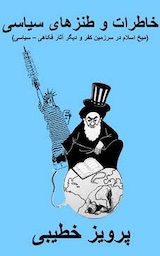Cartoon by Behnam Mohammadi
Wanted: A Democracy Assistance Strategy for Iran
By Lauren Mooney
Modern Diplomacy: At the second Summit for Democracy, U.S. Secretary of State Antony Blinken underscored the importance of advancing gender equality and women’s participation worldwide, including by commending the brave women of Iran for fighting for “woman, life, and freedom.” Yet, the people of Iran continue to face brutal repression as the Islamic Republic kills, tortures, arrests and assaults Iranians who are fighting for basic rights.
Iran has seen a sharp rise in human rights violations over the past seven months, when protests erupted across the country—sparked by the death of Mahsa Zhina Amini, a young Kurdish Iranian who died in the custody of the morality police for an “improper hijab.” These protests have trained a spotlight on deep societal grievances fostered by over four decades of persecution, oppression and impunity which cannot be reversed by the regime’s crackdown. The Islamic Republic now faces a dire crisis of legitimacy.
Although the United States has taken some steps to support the democratic movement in Iran, including by expressing solidarity with the demonstrators, the time has come for a more active stance in supporting those risking their lives to promote change by helping opposition leaders and providing assistance to pro-democracy forces to enable them to advance peace and human rights in Iran. Working through the State Department, USAID and independent NGOs, the U.S. can draw on existing resources and experience on promoting peaceful, political transitions to help democratic activists articulate their vision of a democratic future.
To begin with, the U.S. government should amplify and support the opposition leaders in developing a united vision for Iran’s future. Momentum for change has found footing as opposition leaders collaborate to establish a new political identity that rests on the principles of democracy, secularism, and human rights. This has also taken shape in inclusion, which is a first step in enshrining the principles of human rights, inclusion and a secular democracy.
The U.S. should seize this opportunity to provide dialogue platforms for opposition leaders and activists inside Iran to work across divides to refine their strategy, key policy priorities and their vision for democratic transformation. This could also entail providing technical assistance to Iranian activists on issues of peace, democracy, and governance. International support for the opposition as a legitimate alternative to the regime could reinvigorate hope among the protestors in Iran, while helping activists become better organized around clear goals could maximize the chance of a democratic breakthrough.
The U.S. government should adopt a long-term strategy and start planning how to support a democratic Iran, in line with USAID’s emphasis on supporting “bright spots” and leveraging the momentum of democratic openings. Given that protest movements and political transitions alike sometimes stall or encounter barriers, the U.S. should maintain flexibility as it anticipates and supports a democratic breakthrough. Whether the regime falls in the next few months or years, the U.S. should be prepared to provide assistance that empowers the Iranian people to build a new democratic foundation. This could include assisting an interim government, preparing leaders to govern, supporting political party development, codifying inclusion in a legal framework, mitigating the impacts of spoilers and managing security sector reform.
In designing these plans for assistance, policymakers should take care to encourage an inclusive approach that recognizes the rights and priorities of youth, women, ethnic, religious, sexual, and racial minorities. Under the Islamic Republic, these groups currently face extreme forms of discrimination, persecution and violations of human rights. After decades of oppression, women and youth are at the forefront of the uprising today—the U.S. should amplify their messages and support the fight for women’s rights as part of its policy objectives.
Minimizing the risk of elite capture and maximizing public participation will be critical to unifying the Iranian opposition, as well as helping ensure that inclusion is featured in a long-term vision for democracy in the country. This should include mitigating backlash from elite and dominant groups by educating and informing the public of the benefits of expanding political participation to include women and ethnic, religious, sexual, and racial minorities.
Advancing democracy and governance in any country is a long-term endeavor, and in Iran it would be no different. If the democratic movement in Iran were to succeed, it would represent an extraordinarily consequential event in the global fight for democracy. As President Biden has said, “We’re at an inflection point in history, where the decisions we make today are going to affect the course of our world for the next several decades.” Enabling the Iranian people to lead the way in defining the future of democracy in their country could impact the future for decades to come. The U.S. should stand on the right side of history.










Comments